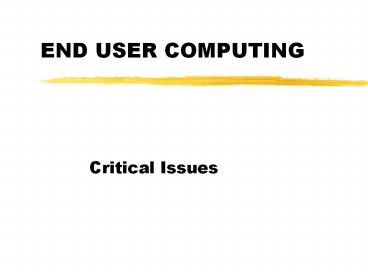END USER COMPUTING PowerPoint PPT Presentation
Title: END USER COMPUTING
1
END USER COMPUTING
- Critical Issues
2
Key Issues in IS ManagementNeiderman, Brancheau,
Wetherbe, MISQ, 1991(Gray, et. al.)
- Developing an information architecture
- Making effective use of data
- Improving IS strategic planning
- Recruiting, and developing human resources
- Facilitating organizational learning and use of
IS - Building a responsive IT infrastructure
- Aligning IS with the enterprise
- Using IS for competitive advantage
- Improving the quality of software development
- Developing telecommunications systems
3
Types of Information Systems Sprague Watson,
DSS for Management, Prentice Hall, 1996
- Type I (Procedure)
- High volume
- Low transaction cost
- Well structured
- Measurable
- Process efficiency
- Data
- Clerical
- Type II (Goal)
- Low volume
- High trans. value
- Poorly structured
- Hard to measure
- Goal effectiveness
- Concepts
- Mgrs, professionals
4
IS Development Approaches
- Systems Development Life Cycle
- Information Center (DSS)
- Object and Component
5
Type ILarge Systems
- Intercommunications among applications
- Formal methodologies
- CASE technologies
- Purchased products
- Outsourcing
6
Type ISDLC
- Type I systems
- Large and Costly
- Cost justified
- Formal stages of evaluation
- Stages carefully reviewed and formally approved
- Data, Process, Communications
7
Type IIInformation Center (DSS)
- Type II systems
- Relatively small and inexpensive
- Value justified
- Prototyping and evolutionary design
- Data, Dialog, Model
8
End User Computing (EUC)
- End User Computing refers to systems in which
the user does some of the programming. Arises
from - Capacity of Computers
- Cost of Hardware
- Friendly Software
- Data Communications
9
EUC Issues
- Data extraction (warehouses) and availability
- System design and development
- Management and control
- New technologies
- EIS, GDSS and Artificial Intelligence, Expert
Systems and Groupware
10
Prototyping Iterative Design
- Data
- Trial Solution
- User Experimentation
- Revised Solution
11
Object Oriented(Event Driven)
- User owned
- Small and experimental
- Dialog driven, reusable code
- Combines data and process
12
Object Issues
- Reliability of tools and software
- Design methodologies
- Standards and portability
- Extent of value
13
Type I Design
- Systems Development Life Cycle Formal
development of systems in progressively detailed
stages - Initial investigation
- Feasibility
- General design
- Detailed design
- Implementation
- Maintenance
14
Type I Design
15
Type II Design
DATA
MODEL
DIALOG
USER
16
Development Roles
- User
- Intermediary (Chauffeur)
- Builder
- Technical Support
- Toolsmith
17
Design Philosophy
- Functional
- Entity
- Dialogue
- Event
18
Distributed Management
- Business within a business
- IS internal partnerships
- Virtual organizations
- Outsourcing and consultants
- Personnel management
19
Ownership
Data
Process
User Owned
IS Owned
20
Information AccessIT User Partnership

